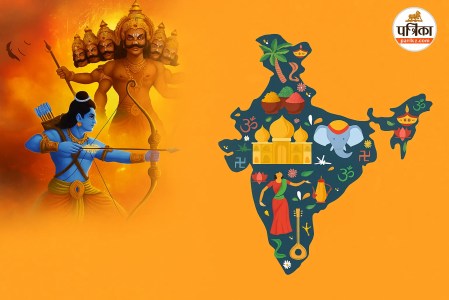
Dussehra, also known as Vijayadashami, is one of the major festivals in India, symbolising the victory of good over evil. On this day, Lord Rama vanquished Ravana, which became an emblem of good triumphing over evil. Various parts of India have their own unique traditions for celebrating Dussehra. While some regions feature colourful enactments of Ramlila, others erect grand pandals for Durga Puja, and in some places, effigies of Ravana are burnt. If you want to know how Dussehra is celebrated in different states of India, detailed information is provided here.
In West Bengal, Dussehra is celebrated as Durga Puja. Grand pandals are set up across the city, where idols of Goddess Durga are installed. On Vijayadashami, married women observe the tradition of "Sindoor Khela" by applying vermilion to each other. Following this, the idols of the Goddess are immersed in the Hooghly River.
The Kullu Dussehra in Himachal Pradesh is world-renowned. This festival begins with the worship of Lord Raghunath Ji and involves palanquins of deities from far-flung villages. Cultural showcases, folk dances, and music make it unique. This year's event is dedicated to families affected by the disaster.
In Gujarat, the spirit of Dussehra is intertwined with the Navratri celebrations of Garba and Dandiya. In cities like Ahmedabad, Surat, and Vadodara, people dance all night in traditional attire. The beats of the drums and folk songs make this festival even more vibrant.
In the capital, Delhi, Dussehra signifies grand Ramlila performances. The epic tale of the Ramayana is staged in various grounds across the city. On the final day, huge effigies of Ravana, Meghnad, and Kumbhakarna are burnt. Thousands of people gather at grounds like Lal Qila Maidan, Dwarka, and Ramlila Maidan. This spectacle becomes a symbol of the victory of good over evil.
Mysore Dussehra holds historical significance. The Mysore Palace is illuminated, and a traditional procession called "Jamboo Savari" takes place, featuring grand elephant rides, bands, and dance troupes. This event spans ten days and highlights the cultural identity of Karnataka.
Bastar Dussehra is considered the longest festival in India, lasting for approximately 75 days. Here, Goddess Dantewari is worshipped, and tribal traditions such as Pata Yatra, Nisha Yatra, and Muria Darbar are organised. This festival is a remarkable confluence of tribal culture and faith.
In Uttar Pradesh, Dussehra in cities like Varanasi, Lucknow, and Kanpur is associated with Ramlila enactments and the burning of Ravana's effigy. Local artists portray Lord Rama and other characters. On the final day, the effigies are burnt, drawing crowds of thousands to witness the event.
Published on:
29 Sept 2025 05:42 pm

